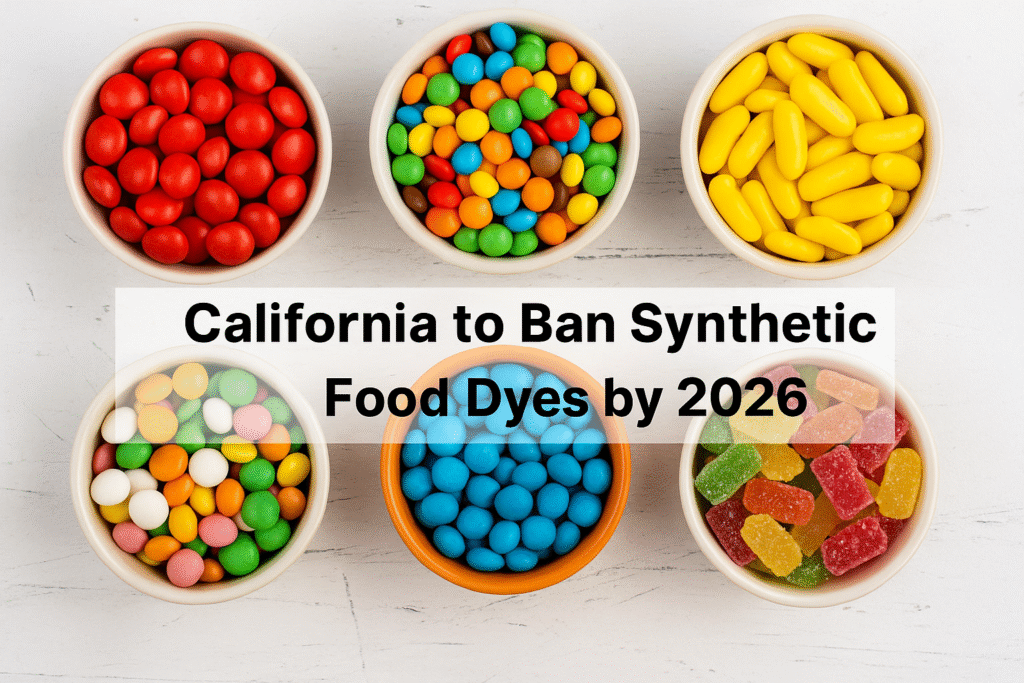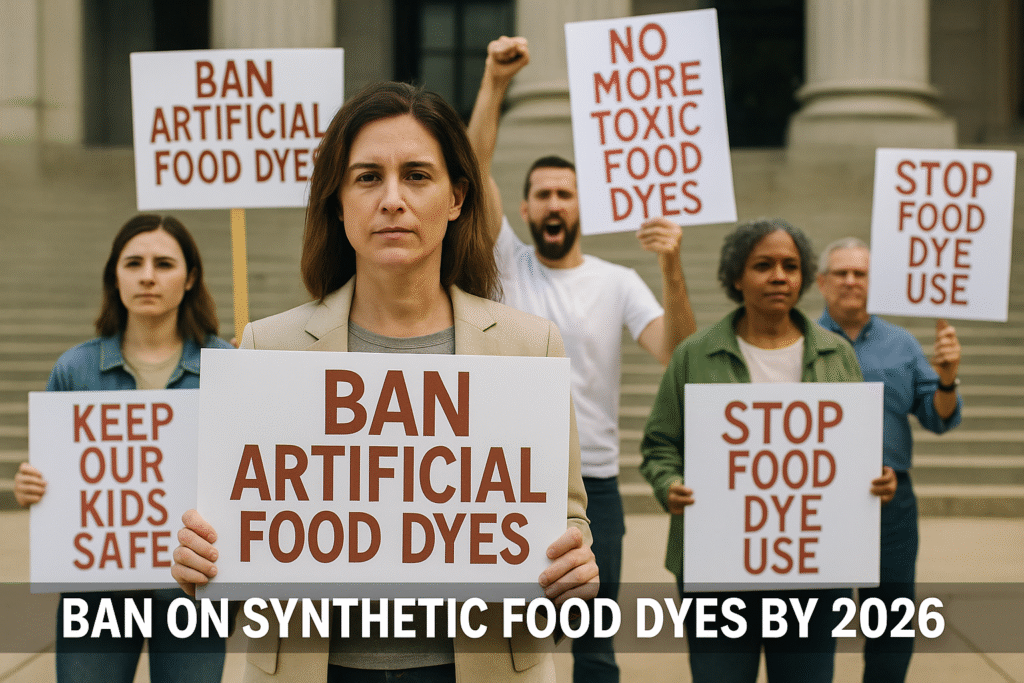Synthetic Food Dyes Ban 2026 is now a reality in the U.S., as health officials move to eliminate artificial colorants like Red No. 40 and Yellow No. 5 by the end of next year. The policy, backed by scientific evidence and rising consumer concern, marks a major shift in national food safety standards.
The regulation, championed by Health Secretary Robert F. Kennedy Jr., marks a significant shift in national food policy. It aligns the U.S. more closely with countries like the United Kingdom and those in the European Union, where several artificial dyes have long been restricted or labeled with warnings. The move is being hailed as a victory by health advocates and consumer groups who have campaigned for clearer labeling and safer ingredients in processed foods.
What Are Synthetic Food Dyes—and Why Are They Being Banned?
Synthetic food dyes are artificial colorants derived from petroleum that are widely used in beverages, snacks, candies, cereals, and even some medications. Their primary role is to enhance the visual appeal of products—often making them appear more vibrant, fruity, or flavorful than they truly are.
Despite their popularity in the food industry, several of these dyes have been the subject of ongoing controversy. Studies suggest potential links to:
- Hyperactivity and behavioral issues in children
- Allergic reactions in sensitive individuals
- DNA damage and cell toxicity in animal models
- Potential carcinogenic effects, though evidence remains inconclusive in humans
The Red No. 40, for example, has been banned in several European countries due to its association with hyperactivity and behavioral changes in children. In contrast, it remains one of the most widely used dyes in the United States—found in products ranging from breakfast cereals to soft drinks.
Public Pressure and Shifting Regulatory Standards
The planned ban on synthetic dyes comes after years of mounting pressure from consumer advocacy groups, scientists, and health-conscious parents. Campaigns like the Center for Science in the Public Interest’s “Food Dyes: A Rainbow of Risks” and grassroots petitions have drawn attention to the potential behavioral and neurological risks associated with artificial colors—especially among children with attention-deficit disorders.
In response to these concerns, some school districts have already implemented policies limiting foods with artificial colors from being served in cafeterias. Likewise, major brands such as Kraft and Nestlé have quietly begun reformulating products sold in Europe and Canada to exclude synthetic dyes—while continuing to sell artificially colored versions in the U.S.
This double standard has become a focal point for reform advocates, who argue that American consumers deserve the same health protections as those in other developed nations.
Industry Reactions and Consumer Trends
Food manufacturers are facing a mixed challenge: reformulating popular products without compromising appearance, flavor, or shelf life. While some companies have welcomed the regulation as a push toward cleaner labels and greater transparency, others are raising concerns over costs, supply chain disruptions, and consumer acceptance.
Natural alternatives like beet juice powder, turmeric, spirulina, and beta-carotene are already in use in some health-conscious brands. However, these options often come with trade-offs in stability and color vibrancy.
Meanwhile, consumer behavior is shifting rapidly. Surveys show that more than 60% of U.S. shoppers now check food labels for artificial ingredients, and the demand for “clean label” products has surged—particularly among Gen Z and millennial buyers. For many, this regulation simply validates a trend already in motion: the move toward foods that are not only safer but also simpler and more transparent.
Scientific Evidence Behind the Health Risks of Food Dyes

The push to ban synthetic food dyes in the United States is not solely political—it’s grounded in a growing body of peer-reviewed scientific research that raises serious concerns about their safety, particularly for children.
A pivotal 2007 study published in The Lancet found that children who consumed a mixture of common food dyes—including Red No. 40 and Yellow No. 5—exhibited increased hyperactivity, even in those without a diagnosed behavioral disorder. This research became a foundation for regulations in the United Kingdom, where products containing these dyes must now carry warning labels.
Further reviews from the Center for Science in the Public Interest (CSPI) cite dozens of studies that show synthetic dyes may:
- Disrupt neurotransmitter function in the brain
- Cause oxidative stress and inflammation in animal models
- Lead to DNA damage and genotoxicity, raising long-term health concerns
- Trigger immune responses or allergic reactions in sensitive individuals
Even the FDA has acknowledged that certain children may be sensitive to synthetic dyes, though regulatory action has lagged behind countries like the UK, Norway, and Austria. Health experts argue that the risk-to-benefit ratio is no longer justifiable, especially when safer, natural alternatives exist.
How the Ban Compares to International Regulations

Compared to other developed nations, the U.S. has historically taken a more lenient stance on food dye safety. The upcoming ban represents a significant regulatory catch-up—bringing U.S. food policy more in line with international norms.
- European Union: Requires warning labels on products containing six artificial dyes since 2010. Many dyes, including Yellow No. 5, are voluntarily phased out by major brands.
- United Kingdom: After the Southampton Study, most major retailers and manufacturers shifted to natural colorants, and synthetic dyes are rarely used today.
- Canada: Allows synthetic dyes but requires them to be listed by name on labels, encouraging consumers to avoid them.
- Australia & New Zealand: Have strict additive codes and approve only a limited number of dyes based on current evidence.
In contrast, many American products—including popular cereals, candies, and beverages—still rely heavily on synthetic colors, with minimal front-of-package labeling. The 2026 deadline aims to close this regulatory gap and protect U.S. consumers with the same standards seen abroad.
What Comes After the Synthetic Food Dyes Ban 2026 in the U.S.
The announcement of the synthetic dye ban is part of a broader movement within public health policy to address chemical additives in the American food system. Experts anticipate further scrutiny of other controversial ingredients, such as:
- Titanium dioxide (used for whiteness in candy and gum)
- Butylated hydroxyanisole (BHA) and butylated hydroxytoluene (BHT)
- Certain preservatives and emulsifiers
Health advocates are also calling for mandatory front-of-package labeling to inform consumers about additive levels, degrees of processing, and nutritional density.
While the food industry adapts, nutrition experts emphasize the importance of public education. As food environments change, so must consumer awareness—particularly around choosing minimally processed, whole-food-based options that nourish rather than harm.
Main Takeaways (Bullet Points)
- The U.S. will ban synthetic food dyes like Red No. 40 and Yellow No. 5 by the end of 2026.
- Scientific evidence links these additives to behavioral issues and potential health risks, especially in children.
- The move follows increasing public pressure and aligns the U.S. with European food safety standards.
- Food companies are responding by reformulating products with natural colorants, but challenges remain.
- Consumer trends are shifting rapidly toward clean-label, additive-free products.
Further Reading
To complement your understanding of food safety and public health, explore our guide:
👉 Ultra-Processed Foods Linked to 124,000 Premature Deaths Annually








One Response